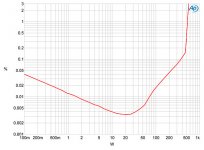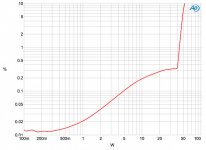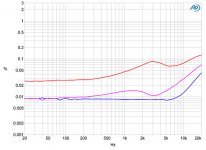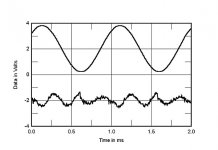Help for those 22's .....
http://www.diyaudio.com/forums/planars-exotics/126342-amp-suggestions-acoustat-spectra-22s.html
http://www.diyaudio.com/forums/planars-exotics/126342-amp-suggestions-acoustat-spectra-22s.html
I'm sure a tube amp that is working at only 30% will sound fine, but can't the same be said about a SS amp?
The sanders amp has a lot of power (1000w per channel?) so that it can work at only at the low level of its potential power, lowering distortion.
The sanders amp has a lot of power (1000w per channel?) so that it can work at only at the low level of its potential power, lowering distortion.
I can't find any test results on the Magtech the 30% number is really only related to SS class A/AB amplfiers not tooobs (mili-20 watts) toobs distortion spectra tend to increase with increased output ...
SS Constellation vs AR75 toob , notice how the SS curve starts high and then decreases the toob on the other hand starts pretty linear then increases gradually. This IMO will account for the subject difference when running in the mili-watt level the Conste will sound it best at even lower than the 30% mark, sonics will have varying quality based on drive...
We can look at others ...
SS Constellation vs AR75 toob , notice how the SS curve starts high and then decreases the toob on the other hand starts pretty linear then increases gradually. This IMO will account for the subject difference when running in the mili-watt level the Conste will sound it best at even lower than the 30% mark, sonics will have varying quality based on drive...
We can look at others ...
Attachments
Last edited:
Those look like THD + N plots. In case of the tube amp the noise is swamping anything below 500mw or so. So you can't say much about low signal THD from that plot.
I'd rather see each harmonic individually plotted against power for a couple of different loads and one against frequency.
I'd rather see each harmonic individually plotted against power for a couple of different loads and one against frequency.
The shape of the curve is as important or more so than the actual number itself, especially since there is no magic THD number to suggest good sonics. My take is the toobs will be subjectively better up to 10 watts vs that particular SS amplifier, if using high sensitivity speakers.
The shape you see is noise, not distortion. Because the distortion is so much lower than that of the tube amp all you see is noise below 10W.
The shape is a combination of Noise and distortion, if you want to look at distortion only, the distortion decreases as power is increased from the miliwatt level and hence follows the same sig as the noise vs THD curve .
Fig.7 Constellation Performance Centaur, THD+N (%) vs frequency at 18V into: 8 ohms (blue), 4 ohms (magenta), 2 ohms (red).
Fig:8 Constellation Performance Centaur, 1kHz waveform at 50W into 8 ohms, 0.005% THD+N (top); distortion and noise waveform with fundamental notched out (bottom, not to scale).
Fig.7 Constellation Performance Centaur, THD+N (%) vs frequency at 18V into: 8 ohms (blue), 4 ohms (magenta), 2 ohms (red).
Fig:8 Constellation Performance Centaur, 1kHz waveform at 50W into 8 ohms, 0.005% THD+N (top); distortion and noise waveform with fundamental notched out (bottom, not to scale).
Attachments
Last edited:
Hmm I don't understand what's not to understand.
That downward slope below 10W is a typical plot of a constant noise source vs power. But if you don't believe me.
I wanted to see all the graphs so I looked up the measurements, and found this accompanying text:
"Fig.4, which plots the percentage of THD+noise against output power into 8 ohms, indicates that the Centaur slightly exceeds its specified 500W into this load, clipping (defined as when the THD+N reaches 1%) at 520W (27.16dBW). The minimum THD+N is very low, at 0.0033%; the downward slope of the trace below 20W in this graph reveals that the distortion is actually below the noise floor at low powers. (The noise, being constant, becomes an increasing percentage of the signal level as the power is reduced.) "
Constellation Audio Performance Centaur Mono monoblock power amplifier Measurements | Stereophile.com
So when you said "notice how the SS curve starts high and then decreases" you are looking at noise, not distortion. Which is the point I was trying to make. You can't say anything about the distortion below 10W from that graph because it hides under the noise floor (for that typical measurement).
That downward slope below 10W is a typical plot of a constant noise source vs power. But if you don't believe me.
I wanted to see all the graphs so I looked up the measurements, and found this accompanying text:
"Fig.4, which plots the percentage of THD+noise against output power into 8 ohms, indicates that the Centaur slightly exceeds its specified 500W into this load, clipping (defined as when the THD+N reaches 1%) at 520W (27.16dBW). The minimum THD+N is very low, at 0.0033%; the downward slope of the trace below 20W in this graph reveals that the distortion is actually below the noise floor at low powers. (The noise, being constant, becomes an increasing percentage of the signal level as the power is reduced.) "
Constellation Audio Performance Centaur Mono monoblock power amplifier Measurements | Stereophile.com
So when you said "notice how the SS curve starts high and then decreases" you are looking at noise, not distortion. Which is the point I was trying to make. You can't say anything about the distortion below 10W from that graph because it hides under the noise floor (for that typical measurement).
Agree and my statements and suggestions were not about nor to dispute such , so I 'm also not sure whats not to understand, pretty simple really, the toob amp noise and thd increases with output , the SS decreases with increased output , hitting its min level at approx 30% of output ( bias amt changes this actual value ) before climbing and kneeing . Amplfiers that do this ( mostly SS) tend to not have favorably sonics operating in the miliwatt to 10watt level , nothing to do with the actual thd value measured , more to do with the sonic changes experienced by the listener due to the changes.
A thd graph at 1,5, 10,20,40 volt, would have the same curve, starting higher before lowering at increased output .
A thd graph at 1,5, 10,20,40 volt, would have the same curve, starting higher before lowering at increased output .
Last edited:
So for those running high sensitivity speakers and or listening at moderate levels, may find that a 20-50 watt per channel SS sounds better to them than a 300 watt per ch version due to the 30% number i suggested you can try this yourself by measuring actual voltage being used when listening or Pano's simple test ...
really, the toob amp noise and thd increases with output , the SS decreases with increased output
Distortion, yes, noise, I seriously doubt it.
Ummm... I don't think that flies a.wayne.
nice idea, but just not a theory that bears any relationship to real amplifiers.
As far as why tube amps sound "better" than solid state amps on Acoustats, my take is that they sound "better" in the lower mids/upper bass for the most part - speaking in general terms. WHY that should be is something that bears some discussion (perhaps).
I think it has nothing to do with HF extension vs. output inductance, and nothing to do with power, and only maybe something to do with DF (damping factor).
It may also relate to how a given amp drives what is a reactive load, since the ESL *is* a capacitor, although driven by two transformers. Many solid state amps are spectacularly "unhappy" when faced with a reactive load in as much as if they are not actually unstable they may produce harmonics that are not as good as the typical test protocols indicate. Tube amps also can produce some "icky" stuff when faced with reactive loads, but they seem to (generally speaking now) be more "gracious" in terms of what "nasties" get produced.
Having run Acoustats for many years, and having run them with a very wide range of commercial and DIY amps, my own and from others, including Strickland's TNT200 (made to run the Acoustats), it's pretty clear to me that the cleanest and seemingly the most "accurate" presentation has been with my own Symphony No.1 amplifier, and the most euphonic and pleasant presentation has been with a PP 811A amplifier (~150 watts).
The idea that the first watt plays a very large role with Acoustats, I think is likely not the case, since they are actually fairly inefficient (good for ESLs, but not compared to other speakers) and so average listening levels require quite a few watts more than one might expect... even so, an amp with issues in the xover region ought to be avoided anyhow. You *do* need a lot of power (voltage swing) to keep headroom and avoid clipping with the Acoustats. This is one reason that OTLs were and are popular for driving ESLs. (something to think about there). But with the OTLs I have heard, the highs are usually spectacular on ESLs but not the bass and lower mids quite so much.
Ymmv.
_-_-
nice idea, but just not a theory that bears any relationship to real amplifiers.
As far as why tube amps sound "better" than solid state amps on Acoustats, my take is that they sound "better" in the lower mids/upper bass for the most part - speaking in general terms. WHY that should be is something that bears some discussion (perhaps).
I think it has nothing to do with HF extension vs. output inductance, and nothing to do with power, and only maybe something to do with DF (damping factor).
It may also relate to how a given amp drives what is a reactive load, since the ESL *is* a capacitor, although driven by two transformers. Many solid state amps are spectacularly "unhappy" when faced with a reactive load in as much as if they are not actually unstable they may produce harmonics that are not as good as the typical test protocols indicate. Tube amps also can produce some "icky" stuff when faced with reactive loads, but they seem to (generally speaking now) be more "gracious" in terms of what "nasties" get produced.
Having run Acoustats for many years, and having run them with a very wide range of commercial and DIY amps, my own and from others, including Strickland's TNT200 (made to run the Acoustats), it's pretty clear to me that the cleanest and seemingly the most "accurate" presentation has been with my own Symphony No.1 amplifier, and the most euphonic and pleasant presentation has been with a PP 811A amplifier (~150 watts).
The idea that the first watt plays a very large role with Acoustats, I think is likely not the case, since they are actually fairly inefficient (good for ESLs, but not compared to other speakers) and so average listening levels require quite a few watts more than one might expect... even so, an amp with issues in the xover region ought to be avoided anyhow. You *do* need a lot of power (voltage swing) to keep headroom and avoid clipping with the Acoustats. This is one reason that OTLs were and are popular for driving ESLs. (something to think about there). But with the OTLs I have heard, the highs are usually spectacular on ESLs but not the bass and lower mids quite so much.
Ymmv.
_-_-
... the toob amp noise and thd increases with output , the SS decreases with increased output
The noise in that plot of the SS amp does not decrease with output, it's constant. It appears to decrease because it's plotted in reference to the output level of the amp.
Where did i say noise decrease's Arend, you are discussing the graph with semantics, I'm saying amps which have this kind of "noise/THD plot" will sound different from one similar to the AR toob plot. I'm sure it's obvious to you what the differences are ........
Last edited:
Ummm... I don't think that flies a.wayne.
nice idea, but just not a theory that bears any relationship to real amplifiers.
As far as why tube amps sound "better" than solid state amps on Acoustats, my take is that they sound "better" in the lower mids/upper bass for the most part - speaking in general terms. WHY that should be is something that bears some discussion (perhaps).
I think it has nothing to do with HF extension vs. output inductance, and nothing to do with power, and only maybe something to do with DF (damping factor).
It may also relate to how a given amp drives what is a reactive load, since the ESL *is* a capacitor, although driven by two transformers. Many solid state amps are spectacularly "unhappy" when faced with a reactive load in as much as if they are not actually unstable they may produce harmonics that are not as good as the typical test protocols indicate. Tube amps also can produce some "icky" stuff when faced with reactive loads, but they seem to (generally speaking now) be more "gracious" in terms of what "nasties" get produced.
Having run Acoustats for many years, and having run them with a very wide range of commercial and DIY amps, my own and from others, including Strickland's TNT200 (made to run the Acoustats), it's pretty clear to me that the cleanest and seemingly the most "accurate" presentation has been with my own Symphony No.1 amplifier, and the most euphonic and pleasant presentation has been with a PP 811A amplifier (~150 watts).
The idea that the first watt plays a very large role with Acoustats, I think is likely not the case, since they are actually fairly inefficient (good for ESLs, but not compared to other speakers) and so average listening levels require quite a few watts more than one might expect... even so, an amp with issues in the xover region ought to be avoided anyhow. You *do* need a lot of power (voltage swing) to keep headroom and avoid clipping with the Acoustats. This is one reason that OTLs were and are popular for driving ESLs. (something to think about there). But with the OTLs I have heard, the highs are usually spectacular on ESLs but not the bass and lower mids quite so much.
Ymmv.
_-_-
Of course it wont fly Bear, because i never said anything about sounding better on acoustats. But you can try the experiment yourself , when you find yourself preferring one amp over the other , check voltage being used and then do your own plot, you are quite capable of doing such..
Ciao
PS: Academic to understand the amps in discussion have to be stable on the load to begin with ...
Last edited:
a.wayne, you seem to be misunderstanding the plots you present.
The noise is a constant, but expressed as a percentage of the output power, you get the plot that you see.
If you interpret that as there being a "sweet spot" at some power level (you mentioned 30%?) then you are incorrectly assigning a property that is just not there. Put it another way, any constant level plotted on this scale vs power output appears to be dropping, since the line slopes downward - that is, until the actual distortion level starts to rise and then you see the curve go back up...
stability with a given load is a relative thing. it's usually taken as the amp does not self incinerate. That's not the only criterion to be considered.
The noise is a constant, but expressed as a percentage of the output power, you get the plot that you see.
If you interpret that as there being a "sweet spot" at some power level (you mentioned 30%?) then you are incorrectly assigning a property that is just not there. Put it another way, any constant level plotted on this scale vs power output appears to be dropping, since the line slopes downward - that is, until the actual distortion level starts to rise and then you see the curve go back up...
stability with a given load is a relative thing. it's usually taken as the amp does not self incinerate. That's not the only criterion to be considered.
Forget the plot , do the test , measure your listening voltage and compare , you will see the amp ( SS ) sounds it;s best at approx 30%-50% not in the 5% range of it's rated output and no I'm not misunderstanding the graph posted, i know what it means , i never said the noise was lowered or higher as you and others are stating, what i said was any amplifier (SS)which has a distortion curve that lowers with increased output before kneeing will not sound as good as toobs at miliwatt -5 watt levels, this is when most will prefer the sound of tooobs...
... what i said was any amplifier (SS)which has a distortion curve that lowers with increased output before kneeing will not sound as good as toobs at miliwatt -5 watt levels, this is when most will prefer the sound of tooobs...
The reason this curve starts with a downward slope is that it has distortion lower than the noise floor. There is nothing more you can deduce from that slope. It's like trying to count the stars while someone is shining a flashlight in your eyes. If the valve amp had (much) lower distortion it would look the same.
Take for example this measurement from the Hypex NCore amplifiers which measure (and sound!) exemplary:
An externally hosted image should be here but it was not working when we last tested it.
Since it such a common repeated and wrong conclusion that this means the amp performs less below the 'optimal power' they bothered to explain it in the manual:
An externally hosted image should be here but it was not working when we last tested it.
Concluding, I think your interpretation and conclusions based on these plots is wrong.
I think this thread just shows how important system matching is.
I think there is good and bad amps ss and tube amps.
I had a sugden A21A and it sounded great on my AE speakers but when my brother tried it on his KEF 107.2 speakers it sounded bad.
My brothers cheap NAD sounded much better but the sugden sounded miles better than the NAD on my system.
I think there is good and bad amps ss and tube amps.
I had a sugden A21A and it sounded great on my AE speakers but when my brother tried it on his KEF 107.2 speakers it sounded bad.
My brothers cheap NAD sounded much better but the sugden sounded miles better than the NAD on my system.
1) IF I play my system at 30% of power, you need earplugs (for real)!
2) If you play it at 30% of power you have precious little headroom before clipping
3) My amp measures and sounds fine at 1W and below, or above. Take ur pick, it's about the same, sonically and measurement wise. That's why it's a very good amplifier.
_-_-
PS. explain how your theory works with class A amplifiers?
2) If you play it at 30% of power you have precious little headroom before clipping
3) My amp measures and sounds fine at 1W and below, or above. Take ur pick, it's about the same, sonically and measurement wise. That's why it's a very good amplifier.
_-_-
PS. explain how your theory works with class A amplifiers?
- Status
- Not open for further replies.
- Home
- Loudspeakers
- Planars & Exotics
- Why does my 30w tube amp have better control of my ESLs than my 400w SS amp?



